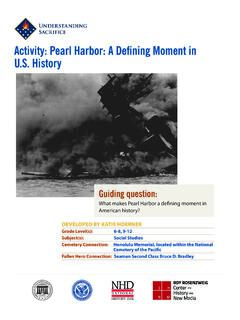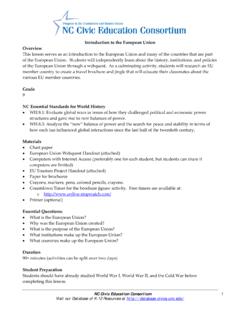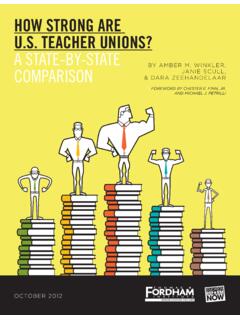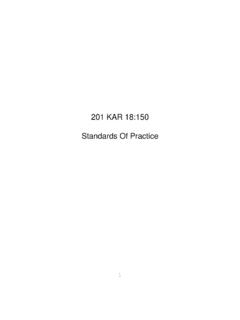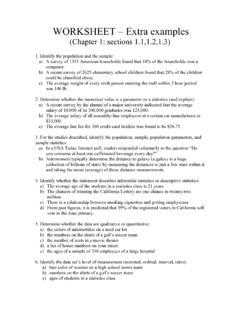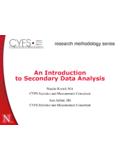Transcription of Lesson 4: Renewable and Nonrenewable Natural Resources
1 4 6 Module, Unit 1: Managing and Conserving Natural ResourcesLesson 4: Renewable and Nonrenewable Natural Resources2934 6 ModuleUnit 1 Lesson 4: Renewable and Nonrenewable Natural ResourcesLesson s ConceptS Renewable Natural Resources are those which can be replaced naturally or through human-assisted actions within a relatively short amount of time ( , within a human lifetime). Examples of Renewable Natural Resources are plants, animals, water, air, and some energy Resources , such as sunlight. Nonrenewable Natural Resources are those available in limited amounts and take millions of years to be replaced; therefore, people can rely only on those deposits already in existence.
2 Examples of Nonrenewable Natural Resources are most minerals ( , iron ore) and some energy Resources ( , fossil fuels).PURPOSES tudents learn the difference between renew-able and Nonrenewable Natural Resources . They also learn that people in the United States use a large number of Nonrenewable Resources which are acquired from other Part II, older students (grades five and six), will participate in a simulation activity that focuses on the scarcity of some mineral this Lesson students will: Determine which Natural Resources are considered Renewable and which are con-sidered Nonrenewable .
3 Classify items found in the outdoors and in the classroom as being made from Renewable Natural Resources , nonrenew-able Natural Resources , or both types of Resources . Write a pledge to avoid wasting one spe-cific material at school or at home. Design posters or a bulletin board featur-ing pictures of Renewable and nonrenew-able Natural Part I younger students ( grade four) will: Identify the location of some mineral reserves, such as bauxite, iron ore, and tin. Read a chart to determine how long cer-tain mineral Resources are likely to last. For Part II, older students (grades five and six) will: Search the classroom for various colored beads that represent finite mineral resourc-es.
4 Compare the numbers acquired in a simu-lation game to the actual global reserve base of specific mineral Resources . Analyze charts and graphs concerning mineral Resources . Arrange in order some mineral Resources that are most abundant to those that are less TO CALIFORNIA S CONTENT STANDARDS AND FRAMEWORKS Students compare Renewable to nonrenew-able Natural Resources . They classify items outdoors and in the classroom as being made from Renewable or Nonrenewable Natural Resources or from both types of Resources . - All Resources used by humans, includ-ing fuels, metals, and building materi-als, ultimately come from the Earth.
5 Many of these Resources are not in endless supply. They have taken many thousands and millions of years to develop and accumulate. They must be used with care, conserved, and recy-cled. (Science Framework, page 97)4 6 ModuleUnit 1 CLOSING THE LOOP4 6 Module, Unit 1: Managing and Conserving Natural Resources294 - Scientific progress is made by asking meaningful questions and conducting careful investigations. As a basis for understanding this concept .. students will: classify objects .. based on ap-propriate criteria .. (Science Content Standards, Grades K 12; grade 5; Inves-tigation and Experimentation, Standard 5a) - Students know.
6 Different Natural energy and material Resources , includ-ing air, soil, rocks, minerals, petroleum, fresh water, wildlife, and forests, and classify them as Renewable or nonre-newable .. (Science Content Standards, Grades K 12; grade 6; Resources , Stan-dard 6b) Students work together to gather colored beads and identify what mineral each color of bead represents. - To participate effectively in society, students need to: Develop personal skills .. group interaction skills (and) .. social and political participa-tion skills. History Social Science Framework, page 24) Students analyze charts and graphs.
7 - Students interpret one- and two-vari-able data graphs to answer questions about a situation. (Mathematics Content Standards for California Public Schools, Kindergarten Through grade Twelve, page 18)SCIENTIFIC THINKING PROCESSES observing, communicating, comparing, or-dering, classifying, relatingTime45 minutes to prepare for the Lesson ; 60 90 minutes to implement the lessonVocabularyecosystem, Nonrenewable Natural Resources , Renewable Natural resourcesPreparation___ 1. Read the Background Information for the Teacher at the end of this 2. Make a transparency of Some of the Earth s Natural Resources (page 299).
8 For Younger Students ( grade Four)For Part I, Analyzing a Chart ___ Make a transparency of Life Expectancies and Main Consumers of Some Nonrenewable Natural Resources (page 300).For Older Students (Grades Five and Six)For Part II, Simulating the Scarcity of Some Mineral Resources ___ 1. Gather beads of different colors and coins to represent mineral Resources (see the numbers and colors listed on A Look at What s Left ). An option to using beads and coins is to use cutout circles from construction 2. Hide beads and coins throughout the classroom. (Make sure that some of the beads are well hidden, so they will not be found immediately.)
9 ___ 3. Make transparencies of A Look at What s Left (page 301); Depletion Time for Nonrenewable Resources (page 302); Life Expectancies and Main Consumers of Some Nonrenewable Natural Resources (page 300); and A World Map (page 303).___ 4. Make copies for each group of A Look at What s Left, Life Expectancies and Main Consumers of Some Nonrenew-able Natural Resources , and A World Map. MATERIALSFor Pre-Activity Questions ___ The transparency, Some of the Earth s Natural Resources For Younger Students ( grade Four)For Part I, Analyzing a Chart ___ Iron nail, lead fishing weight, aluminum can, and a tin can___ Large map of the world___ A transparency of Life Expectancies and Main Consumers of Some Nonrenewable Natural Resources 4 6 Module, Unit 1: Managing and Conserving Natural ResourcesLesson 4.
10 Renewable and Nonrenewable Natural Resources2954 6 ModuleUnit 1 For Older Students (Grades Five and Six)For Part II, Simulating the Scarcity of Some Mineral Resources ___ Transparencies of each of the following: A Look at What s Left, Depletion Time for Nonrenewable Resources , Life Expectan-cies and Main Consumers of Some Nonre-newable Natural Resources , and A World Map ___ Charts titled, A Look at What s Left, Depletion Time for Nonrenewable Re-sources, and Life Expectancies and Main Consumers of Some Nonrenewable Natural Resources , one for each group of students___ Colored beads and coins in numbers re-quired (See A Look at What s Left.)

